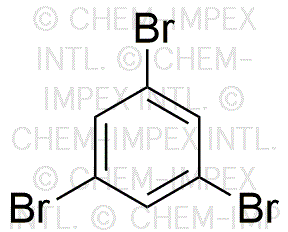1,3,5-Tribromobenzene is widely utilized in research focused on:
- Flame Retardants: This compound is used in the development of flame retardant materials, particularly in textiles and plastics, enhancing safety in consumer products.
- Organic Synthesis: It serves as a versatile building block in organic synthesis, allowing chemists to create complex molecules for pharmaceuticals and agrochemicals.
- Environmental Studies: Researchers employ it in studies assessing the environmental impact of brominated compounds, contributing to better understanding and regulation of pollutants.
- Material Science: It is utilized in the formulation of advanced materials, including polymers and composites, which exhibit improved thermal and mechanical properties.
- Analytical Chemistry: This compound is used as a standard in various analytical methods, aiding in the accurate detection and quantification of brominated substances in samples.
General Information
Properties
Safety and Regulations
Applications
1,3,5-Tribromobenzene is widely utilized in research focused on:
- Flame Retardants: This compound is used in the development of flame retardant materials, particularly in textiles and plastics, enhancing safety in consumer products.
- Organic Synthesis: It serves as a versatile building block in organic synthesis, allowing chemists to create complex molecules for pharmaceuticals and agrochemicals.
- Environmental Studies: Researchers employ it in studies assessing the environmental impact of brominated compounds, contributing to better understanding and regulation of pollutants.
- Material Science: It is utilized in the formulation of advanced materials, including polymers and composites, which exhibit improved thermal and mechanical properties.
- Analytical Chemistry: This compound is used as a standard in various analytical methods, aiding in the accurate detection and quantification of brominated substances in samples.
Documents
Safety Data Sheets (SDS)
The SDS provides comprehensive safety information on handling, storage, and disposal of the product.
Product Specification (PS)
The PS provides a comprehensive breakdown of the product’s properties, including chemical composition, physical state, purity, and storage requirements. It also details acceptable quality ranges and the product's intended applications.
Certificates of Analysis (COA)
Search for Certificates of Analysis (COA) by entering the products Lot Number. Lot and Batch Numbers can be found on a product’s label following the words ‘Lot’ or ‘Batch’.
*Catalog Number
*Lot Number
Certificates Of Origin (COO)
This COO confirms the country where the product was manufactured, and also details the materials and components used in it and whether it is derived from natural, synthetic, or other specific sources. This certificate may be required for customs, trade, and regulatory compliance.
*Catalog Number
*Lot Number
Safety Data Sheets (SDS)
The SDS provides comprehensive safety information on handling, storage, and disposal of the product.
DownloadProduct Specification (PS)
The PS provides a comprehensive breakdown of the product’s properties, including chemical composition, physical state, purity, and storage requirements. It also details acceptable quality ranges and the product's intended applications.
DownloadCertificates of Analysis (COA)
Search for Certificates of Analysis (COA) by entering the products Lot Number. Lot and Batch Numbers can be found on a product’s label following the words ‘Lot’ or ‘Batch’.
*Catalog Number
*Lot Number
Certificates Of Origin (COO)
This COO confirms the country where the product was manufactured, and also details the materials and components used in it and whether it is derived from natural, synthetic, or other specific sources. This certificate may be required for customs, trade, and regulatory compliance.


